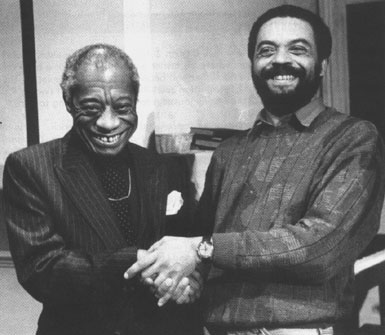
James Baldwin and Anton
Phillips, 1987
Tricycle
Theatre, Kilburn, December 1999
The revival of
James Baldwin's The Amen Corner is a reminder of how
few plays approaching life from an Afro-Carribean
perspective are ever re-staged or admitted to the canon of
classic theatre.
The play is set
in Harlem, 1955; now a period which is fading into the
shadows of history. We are transported to a community which
is struggling to define itself within the no-man's land
between two extremes. One is represented by the almost
crushingly claustrophobic church community with its
puritanical adherence to the social code of 50's America.
The other is the jazz world, where the music implicitly
carries a message of personal spiritual liberation, of
'attitude' and rejection of all the conformity and
repression of the status quo. For the Afro- American of the
time, these two different worlds were intertwined; but also
represented the conflicting ways for the black community to
deal with society.
James Baldwin,
who often spoke of his struggles with his father who was a
preacher, in fact preached in his teens, before breaking
away from that tradition and gravitating towards the
bohemian world of smokey jazz clubs and the Left Bank of
Paris, where he developed into one of America's greatest
writers.
The play, like
most of Baldwin's writing, reflects his personal struggles
and the society he grew up within; and as a piece of drama
is informative in both the social and deeply personal way
that is the aim of good theatre; as well as being highly
entertaining.
Although not
being a great fan of gospel music, I was taken aback from
the first notes sung by the members of the London Community
Gospel Choir who make up some of the members of the cast.
The music is sweet, powerful and uplifting and has the power
to make even the most secular of us feel in touch with
something beyond the immediate, the here and now.
We are given an
insight, both through the play and the music itself, how
close are the two worlds, the sacred and profane; and the
role of music in both defining ones collective social
position, and transcending it.
Behind the
choir is the pianist who accompanies the singing with the
understated jazz fills of a musician finding his way through
the orthodoxy of structure which jazz began to take apart
and rebuild in a multitude of different ways.
For Baldwin
himself, a man who made little secret of his homosexuality
in a time which was intolerant to say the least, and in a
community which relied on conformity for survival; jazz
became the sign of a new time. Although we do not hear the
music itself within the play; it is the ghost of the future
which calls the young pianist away from the fearful inward
looking church. However, Baldwin also demonstrates how the
church is at the heart of the community; with its
surprisingly female - dominated power structure, and the
almost magical powers of life and death expected from the
Pastor, Sister Mary.
The members of
the congregation are played with a gentle irony and empathy
by the actors, and the power struggles amongst the
congregation are shown resulting from poverty, and the
unfulfilled lives of people living in a ghetto.
Despite the
social content, the play actually seems to have the same
uplifting effect on the audience as the music. The acting,
set and arrangement draw you into a world where people are
struggling against the odds, but still managing to produce
light from the darkness that surrounds them.
It is a credit
to Baldwin, and the director Anton Phillips who was
responsible for the first staging (originally at The
Tricycle as well); that the play still has a resonance for
the black community; and as a piece of drama can draw in
even those with no knowledge of the background or issues.
The actors and
singers, as well as the arrangement of both into a seamless
flow carries the audience swiftly through the two and three
quarter hours. This is recommended to anyone who wants
intelligent entertainment, with music that could almost make
me a convert .
© 2000
|
